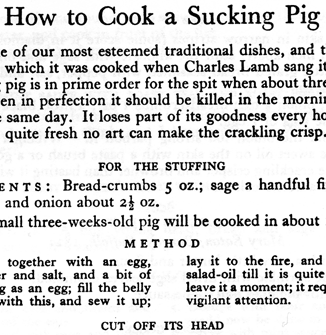Mind you crisp up the dead baby's ears, lest you be scolded
When an old friend sent a cry for help in dealing with the unexpected gift of a suckling pig, which he described unpoetically as "a dead baby in a cardboard box", the right thing to do was clear. I reached for Jane Grigson's Charcuterie and French Pork Cookery.
To achieve "beautiful crackling" on this "festival dish", Jane Grigson recommends basting with olive oil until the skin becomes croquante. In brief, her method calls for a lightweight stuffing of mirepoix and breadcrumbs. I would go heavy on the fennel seeds for a porchetta style. Regarding the presentation of the cochon de lait to table she notes wryly that:
Many cookery-book writers are anxious that the sucking pig be presented on the table with an American mortician's skill. 'Truss the legs and tail in a lifelike position, a small red apple in mouth and cranberries in the eye sockets. Try to preserve as nearly as possible the animal's original shape and form'.
Writing from personal experience, no doubt, Grigson warns:
But do not overemphasise these effects: few people have the robust constitutions required to look a small creature in its cranberry eye.
Next off the bookshelf was Good Things in England by Florence White, descriptively subtitled:
A Practical Cookery Book for Everyday Use
Containing Traditional and
Regional Recipes suited to
Modern Tastes contributed by
English Men and Women between
1399 and 1932...
William Kitchiner (1775-1827), the contributor of this recipe:
has different concerns where it comes to bringing the roast to the table:
Lay...the ears, one at each end, which you must take good care to make nice and crisp, or you will be scolded, as the good man was, who bought his wife a pig with only one ear.
So, apart from finding an oven large enough to accomodate your baby and finding some fellow diners with strong constitutions, the key -- as ever with pork roasts -- is attention to the crackling.
Bagsie an ear.
Good for the heart
Kidney bean casserole
Description
A thick creamy bean stew. Eat with rice and, for example, avocado salad.
Ingredients
- 500g dried kidney (red) beans
- 2 large onions
- head of garlic
- chillies or harissa to taste
- spices (e.g. cumin, coriander seeds etc)
- 50 - 100g cured pork product e.g. bacon, pancetta or chorizo etc if you like to eat pork
- green herbs (e.g parsley, thyme, bay leaf or bouquet garni)
Equipment
- a pressure cooker, or else a large (at least 4 litre) heavy pan with a lid.
Method
soak the beans overnight in cold water. (If you forget this, you can use the 'quick method' which is more or less equivalent: bring the beans to the boil in plenty of water and boil for 2 mins. Turn off the heat and leave covered for 60 mins.)
chop the onions finely and saute gently in plenty of (ideally olive) oil for approx 30 mins until golden
add the garlic, chillies and spices to the onions for the final two minutes
chop the bacon, chorizo and add to the onion / garlic / herb mixture.
meanwhile, change the water and bring the beans to the boil. In a big pan (approx 4 litres) the water should come up to the 3/4 level. Boil for 10 mins (This is important if you are using a slow cooker which will be cooking at less than 100°C. See Wikipedia if more information.).
add the mixture to the beans once they have been boiling for 2 mins.
cook in the pressure cooker for 2.5 hours or in a conventional pan for 6-8 hours or until the beans are soft and the creamy. If you don't have a pressure cooker and your pan is oven safe you can bring the beans to a boil on the hob and then cook overnight in the oven on a very low heat (e.g 80°C)
once the beans are done, if you find that the liquid is rather watery rather than thick and creamy, decant a good portion of the liquid to a heavy wide pan and reduce over a high flame. Add the reduced liquid back to the beans when nice and thick.
now add salt to taste. NB: it's important not to add salt (or acidic ingredients such as tomatoes) until after the beans are cooked. Otherwise the beans and especially their skins stay tough.
Variants
You can use this technique with any other variety of beans which you have or fancy, e.g. black beans, butter beans, flagelot. Adjust the herbs, spices, pork product as you like. Some suggestions:
- whole cumin seeds or a mixture of ground cumin and coriander seeds
- harissa
- raw cashews
- 2 or 3 bay leaves if you find you don't have any fresh green herbs
- fresh thyme (loads)
- fresh coriander (be sparing)
- baby dried figs (with butterbeans)
- smoked paprika (with butterbeans or chickpeas)
- ends of proscuttio or ham which you pick up cheap from the deli
Super-sharp and aesthetic too 1
There is plenty of reference material out there if you like to keep your kitchen knives really sharp. For example try Steve’s Knife Sharpening Links at http://users.ameritech.net/knives/links.htm
A sharp knife is safer (less likely to slip) than a blunt one, will increase your speed and generally be much more satisfing to use.
There are many techniques and tools in use. For culinary use I recommend whetstones lubricated with water.
My advice is as follows:
- allow at least 30mins per month in sharpening if you’re doing 4 knives
- get at least 3 good-sizes whetstones. The best ones, like Global’s ceramic stones or natural Japanese whetstones are expensive but last much better than man-made stones. This is what I use:
- coarse 250 grit for starting off really abused knives
- medium 800 grit, normally the first one you use to “raise the burr” (if you don’t know what this means, read this primer http://users.ameritech.net/knives/knives1c.htm)
- fine 5000 grit polishing stone
- extra fine 8000 grit polishing stone
“Combination stones” are common, where you get 2 grades, one on each face of the stone.
The idea is to start with a coarse or medium grit to remove the old edge and put a new one on. You know you’ve done it when you can feel the burr all the way along the edge of the blade on the side you’re NOT working on. When you’ve done it, repeat the process on the other side of the blade.
This picture (click to see in full)
from Shizuo Tsuji’s seminal textbook “Japanese Cooking: A Simple Art” shows the technique for using a whetstone.
Note that the illustration shows a traditional Japanese blade, sharpened on one side only, like a chisel. Western knives (including Global) are sharpened on both sides, into a “V” section, which is more robust though less sharp.
Once you’ve raised the burr, move onto finer grades of stone and go over your work, polishing and improving the edge. You will see it gleam. Pass the edge across your finger nail; when it’s sharp it will “grab” your nail. If it slides off, keep working.
Work with a gentle touch, especially once you’re in the polishing phase. Concentrate on keeping the angle of the knife against the stone constant.
The hardness of your knife affects the job; the harder the steel, the easier it is to sharpen and the longer it keeps its edge. If you’ve read Kitchen Confidential then you know Anthony Bourdain’s advice to throw away all your expensive Solingen knives (Henckels, Gustav Emil Ern, Wusthof etc) and buy a set of even more expensive Globals. Well, if money’s no object and you don’t miss the greater weight of the German tools for heavier tasks, then go ahead and take his advice because they are a lot less hassle.
Or like many Japanese cooks you may prefer carbon steel (i.e. not stainless) which are harder and again easier to sharpen and keep sharp. According to Shizuo Tsuji, who has taught a generation of cooks at his academy the Ecole Technique Hotcliere Tsuji in Osaka:
many Japanese chefs have two sets of steel knives, using them on alternate days. After honing, they let one set of knives rest for a day so that the “raw” metallic post-honing tastes have time to disappear from the blade’s edge.
And don’t forget this advice, from Tsuji again:
Where there are good knives, there should also be good chopping blocks… The best surface on which cutting can be done is wood… The best chopping blocks are boards with the grain running along the length of the board… There are also plastic boards which are sanitary and kind to knives, but are not aesthetic.
Anyone for ortolan? 7
I was given a copy of Simon Courtauld’s recent piece in The Spectator about the rarified gastronomy of ortolans. (Don’t bother trying to read it online; you can’t.)
A couple of facts cited in this entertaining piece about eating these tiny and highly prized birds puzzled me.
Apparently:
- it is common to put a napkin over your head whilst eating them
- the means of killing is often drowning in Armagnac
Larousse sheds light on the first:
Some gourmands cover their heads with their napkins while they are eating the birds so as to lose none of the aroma. The inventor of this ritual is a priest, a friend of the Brillat-Savarin family (citing James de Coquet)
It would be helpful if anyone can shed light on the Armagnac part.
Don’t bother asking your high-class butcher for ortolan. The birds are now protected and you will have to travel to France or Italy with your napkin if you want to eat one.
But before you go crazy with ortolan-envy, bear in mind Larousse’s warning that the bird:
is prized even more by those who know only the name than by those who have tasted it (citing Grimod de La Reyniere)

